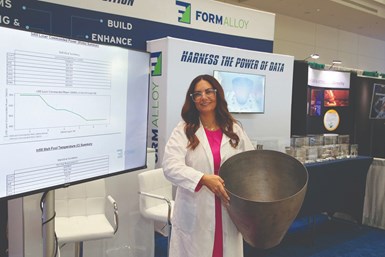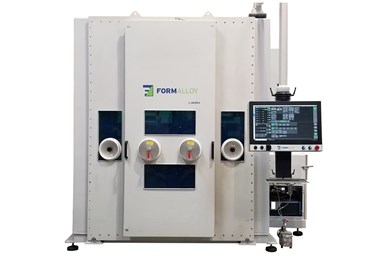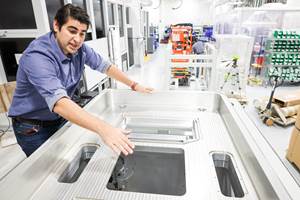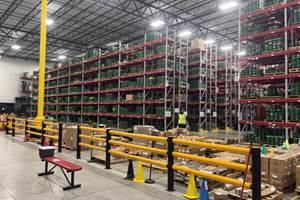AM Bridges High-Stakes Supply Chain Gaps
Gaps in the supply chain can create greater risks with far larger real-world consequences.
Melanie Lang, co-founder/CEO of FormAlloy, holds a 3D printed Rocket Nozzle made of a nickel-based superalloy (Inconel625) from FormAlloy’s directed energy deposition system. Photo Credit: AMT
It’s less the case today, but last year it seemed like any and all inconveniences could be attributed to problems in the supply chain. Did the grocery store run out of your favorite toothpaste? Supply chain. Is the couch you ordered expected to arrive sometime after “The Twelfth of Never”? Oh, that’s the supply chain’s fault for sure. Does your back hurt? I don’t know how, but it’s probably the supply chain.
For most consumers, the stakes for supply chain issues were pretty low. Having to switch brands of deodorant or sit for another three months on a couch you’ve sat in for a decade wouldn’t be the end of the world. In other scenarios, however, gaps in the supply chain can create greater risks with far larger real-world consequences — say, for instance, on the battlefield.
“A big challenge is the ability to support and repair legacy systems on demand,” says Melanie Lang, co-founder and CEO of FormAlloy, a metal AM technology company. Lang notes that, as sophisticated as it is, today’s military still relies on older systems that are still in operation and have not yet been replaced or modernized.
“Today, you have highly sophisticated military systems in the field that have been deployed and used beyond the life they were originally designed for,” she says. “It’s good they have continued to meet the demands, but it can create maintenance and supply chain challenges because you have hard-to-replace parts, and it’s hard to predict when that’s going to happen.”
Even when these systems need repair in the U.S. (on a base rather than in a forward deployment area), it isn’t as though there’s a Home D-O-Depot for specialized parts in a legacy weapons system around the corner. “Even if you were located somewhere on a base in the U.S., there’s no guarantee that you are going to be able to find the same exact part for this piece of equipment, which again may have been designed decades ago,” Lang says. The metal AM technology can also support modernization efforts by providing parts with enhanced performance or life, and again the on-demand repair and replacement.
The FormAlloy L-Series DED features the ability to build, enhance or repair components with single or multimaterial structures.
To the issues of finding the right part, in the right place at the exact right time, AM provides an elegant solution. Rather than having to scramble to find a replacement part when something breaks or having to rejigger what’s available to provide a temporary fix, companies like FormAlloy can design and make the part right away. With AM, the replacement part can be built quickly — and to the exact system specifications — providing a much better option than a kludge to tide things over.
Lang notes that with advanced additive processes and, specifically, direct energy deposition (DED) — which is FormAlloy’s specialty, “you can also make superior performance parts using superior materials and multiple materials
in a single build.”
Not only does additive mean you’re getting a custom-designed part to fix the system — you can also get a part that performs better than the one it replaced. “For example, the replacement part can use some type of corrosion- or wear-resistant material to extend its life further,” she says. “This technology isn’t just meant to be used to sustain older systems, but also to produce really high-quality, high-performing components.”
Beyond just quickly produced, better-performing custom parts, what Lang’s company and others like it are aiming to provide is greater certainty to their customers, military or otherwise. An organization’s leadership can make better decisions and take bolder risks knowing that if and when a critical part breaks in their existing system, they won’t have to cross their fingers and hope the supply chain comes through for them. There’s an additive solution for that, no matter what “that” is.
Lang’s work in the additive world also illustrates the importance of reshoring, not as a hollow political or patriotic gesture, but as plain old common sense.
“If we’ve learned anything in the pandemic, it’s that it’s very important to keep manufacturing somewhat local,” she says. “There are all kinds of issues you might face when sourcing abroad — lead time challenges, material delays. If we can use additive technology and its power to produce things locally or regionally, you can avoid many supply chain challenges and delays.”
Gain more insight from Lang in her interview on IMTS+ and other AM industry leaders at IMTS.com/Watch.
Related Content
Two 12-Laser AM Machines at Collins Aerospace: Here Is How They Are Being Used
With this additive manufacturing capacity, one room of the Collins Iowa facility performs the work previously requiring a supply chain. Production yield will nearly double, and lead times will be more than 80% shorter.
Read MoreSeurat: Speed Is How AM Competes Against Machining, Casting, Forging
“We don’t ask for DFAM first,” says CEO. A new Boston-area additive manufacturing factory will deliver high-volume metal part production at unit costs beating conventional processes.
Read MoreDo Distributors Dream of Digital Inventory? Würth Additive Group Does
It’s more than a dream for Würth Additive Group and its parent company, in fact. Along with supplying additive equipment, the group is now developing solutions for sourcing 3D printed parts in a reliable, elastic digital inventory model.
Read MoreBeehive Industries Is Going Big on Small-Scale Engines Made Through Additive Manufacturing
Backed by decades of experience in both aviation and additive, the company is now laser-focused on a single goal: developing, proving and scaling production of engines providing 5,000 lbs of thrust or less.
Read MoreRead Next
Alquist 3D Looks Toward a Carbon-Sequestering Future with 3D Printed Infrastructure
The Colorado startup aims to reduce the carbon footprint of new buildings, homes and city infrastructure with robotic 3D printing and a specialized geopolymer material.
Read More3D Printed Polymer EOAT Increases Safety of Cobots
Contract manufacturer Anubis 3D applies polymer 3D printing processes to manufacture cobot tooling that is lightweight, smooth and safer for human interaction.
Read MorePostprocessing Steps and Costs for Metal 3D Printing
When your metal part is done 3D printing, you just pull it out of the machine and start using it, right? Not exactly.
Read More





















